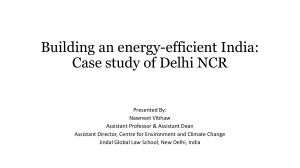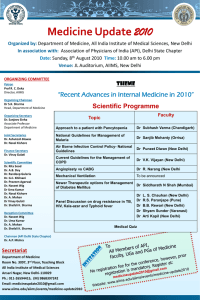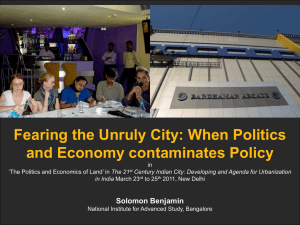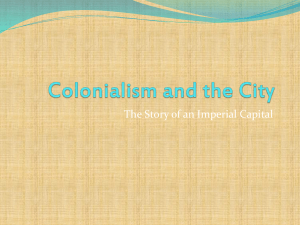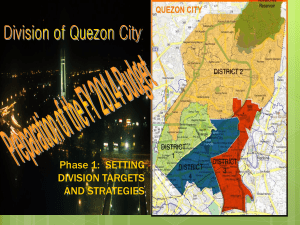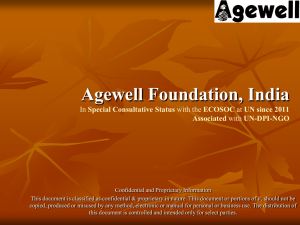Urbanization in India:
advertisement
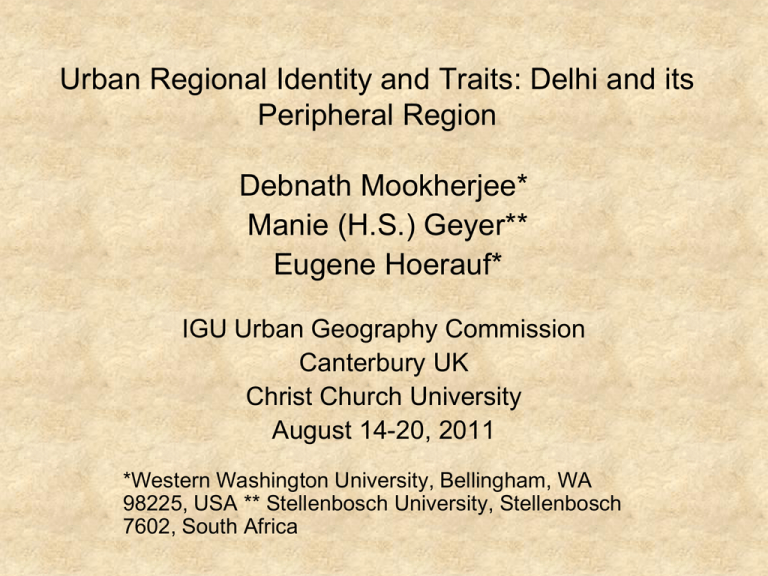
Urban Regional Identity and Traits: Delhi and its Peripheral Region Debnath Mookherjee* Manie (H.S.) Geyer** Eugene Hoerauf* IGU Urban Geography Commission Canterbury UK Christ Church University August 14-20, 2011 *Western Washington University, Bellingham, WA 98225, USA ** Stellenbosch University, Stellenbosch 7602, South Africa Conceptual Background • Core/Periphery – The Semantics of Peripheral Relevance • Dimensions –Spatial / Aspatial • The Centricity Continuum – From Monocentric to Polycentric • Agreements & Ambiguities – Scale, Definition, Disciplinary Approaches, Measurements References: Potter (2001), Copus (2001), Geyer (2006) Agreements & Ambiguities • Broad Consensus (Developed Countries) -- The ‘Demise’ of Monocentricity -- Decentralization of Economic Activities -- Implications of Changes in the ‘Demographic Regime’ -- Mono/Polycentricity – A Continuum, Not an ‘Either /Or’ -- Morphological & Functional Dimensions Agreements & Ambiguities (Cont.) • Ambiguities –‘No Real Consensus,’ e.g., -- Definitions of Polycentricity, ‘What it Really Means’ -- Scales -- Polycentric Forms (PUR, City Regions) -- Measurement Criteria, Variables References: Davoudi (2003), Kloosterman and Musterd (2001), Champion (2001), Meijers and Burger (2010) Polycentric Urban Regions (PURs) • Distinctive Spatial Structure: PUR -- Clustering of Centers -- Size, Spacing, and Size Distribution -- Center-Specialization -- Multi-Centered Metro Areas -- Uniform Homogeneous Regions Polycentric Urban Regions (PURs) • Study Approaches/ Orientations --Functional/ Relational and Morphological -- Scalar Variations – Meso, Macro, Mega Inter and Intra-Regional Perspectives • Dimensions/ Characteristics -- Physical Forms, Political Entity, Functional Relationships, Historical/ Cultural Identity References: Par (2004), Green (2007), Veneri & Burgalassi (2010), Davoudi (2002) Polycentric Urban Regions (PURs) (cont.) -- Urban System – Conforms Broadly to the Central Place Model -- Particular Form of Nodal Region -- Bi-Nodal City-Region • General Agreement: Studies are More or Less Context Specific. Reference: Par (2004), Turok & Bailey (2004), Dick & Rimmer (1998), Davoudi (2002) Important Reminders for Us • Most Research, Conceptualizations, and Debates are in the Context of Developed Countries • Research is Lagging far behind in Context of the Developing World • Context-Specific Empirical Research is Needed for Academic & Policy Purposes An Empirical Observation: The Case of NCR in India • The Delhi core (NCT) grew dramatically during the past five decades . Decadal Growth Rates of Top Metropolitan Agglomerations & the Delhi Core, 1951-2001 A Regional Planning Approach • Concerns over Delhi’s Urban Growth and Spatial Impact Prompted Action • National Commission on Urbanization (NCOU), 1988 • National Capital Region Planning Board (NCRPB), 1985 The Constituent Areas of the NCR • Following an act of Parliament in 1985, a National Capital Region Planning Board (NCRPB) was set up • The NCR was delineated across parts of three adjacent states, Rajasthan, UP, and Haryana • The states voluntarily agreed to surrender their constitutional rights in favor of the Board for planning development of NCR… (NCRPB, 2000, p.xix) The NCR Policy Zones • Three concentric policy zones were formed with the intent of development of urban centers outside of the NCT-Delhi in a polycentric fashion. -- NCT-Delhi (1483 sq. km) -- Delhi Metropolitan Area (DMA) excluding the NCTDelhi (1697 sq. km) -- The rest of the NCR (27,063 sq km). -- Also, a ‘Highway Corridor Zone’, and a ‘Central National Capital Region’ (CNCR) based on the former Delhi Metropolitan Area (DMA), were identified. National Capital Region: Policy Zones Planning Objectives • Halting the Concentration in Delhi • Redistribution of Population and Activities within the NCR • Avoidance of “Amorphous Blobs on the Landscape” • Postulate: Future Settlements would Emerge in PUR forms References: NCOU Report (1988), NCRPB Report (1985) Research Focus • Primary Research Focus in Literature: Resources, Management, Directions of Growth, Carrying Capacity, Infra-Structural Stress • Focus of Our Study: To Observe the Settlement Patterns in the Peripheral Region of the NCR from the Perspective of some Morphological Elements of Polycentric Development as a Baseline Prior to the 2011 Census Reports. References: Ahmed & Choi (2011), Bhandari et al (2007), Jain et al (2011), Banerjee (1996), Mookherjee & Geyer (2011) Research Focus (Contd.) • Study Design: -- The Spatial Entity: The National Capital Region (Core and Periphery) -- The Data Set: Census data—Demographic (Population), Economic (Workers), Spatial (Distance from the Core) -- Urban Settlements: Centers of 20,000 and Over Population Size -- Descriptive Statistics: Core-Periphery Differentials of Population and Occupational Growth Rates, Size and Distance Patterns Growth Rates Main Workers: Delhi Core and Peripheral Centers, 1991-2001 Growth Rates Other Workers: Delhi Core and Peripheral Centers, 1991-2001 Other Workers 250 200 150 100 Other Workers 50 0 Growth Rates Household Workers: Delhi Core and Peripheral Centers, 1991-2001 Household Workers 1400 1200 1000 800 600 Household Workers 400 200 0 Findings • Cities and Towns were concentrated within the 40 km contour line from the NCT-Delhi core • About one-third of Urban Centers (n=51) with growth rates exceeding Delhi core growth were located within the 20 km contour line. • Six of these Centers appear to form a Node around Ghaziabad – a large city of nearly one million population • Distribution of the centers also varied per the state’s developmental status. Findings (contd.) • Majority of the cities and towns in UP grew at a very moderate pace; some showed negative growth. • A cluster of six centers with Ghaziabad as the node in the east appear to be emerging. • An elongated corridor-like zone of four centers extending northward from Sonipat is noticeable. • These zones may evolve into some forms of polycentric urban regions. Concluding Remarks • We have to remember that this has been a glimpse backward at the settlement status a decade ago. Only the new census data can offer us current information. • Our observations clearly point to a trend in spatial development in the NCR at the peripheral region of Delhi. • The trend: a predominantly higher growth rates of population and workers at the immediate periphery of Delhi that far surpassed the growth rates of the core. • However, such a trend, while encouraging, is not impressive. Concluding Remarks (Contd.) • We further detected a possible shaping of future spatial forms in the distribution of urban centers—a ‘node’ in the east and a ‘corridor’ in the north-west. • These are among the rapidly growing centers that may be the ‘incubators’ of regional growth in the future • Above patterns may result partly from NCR policies • It can also be argued that in view of the wide diversity within the NCR and the influence of the Delhi core, such a trend could be inevitable and may have emerged independently. • Answers to such queries must await new data. Acknowledgements We would like to thank ~ • Stephan Freelan, GIS Specialist, WWU, for drawing some of the illustrations; and, • Jonah White, Graduate Student at WWU, for initial compilation of some Census data.
